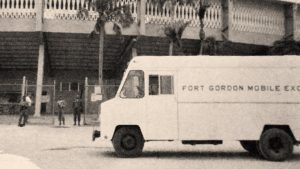
Fifty-nine years ago this week, the United States was in the midst of the Cuban Missile Crisis. For 13 tense days in October 1962, the United States and Soviet Union had a confrontation over Soviet ballistic missile deployment in Cuba.
After an American U-2 spy plane secretly photographed nuclear missile sites being built in Cuba by the Soviet Union, President Kennedy placed a naval blockade around Cuba to prevent the Soviets from bringing in more military supplies. He demanded the removal of the missiles already there and the destruction of the sites. On Oct. 22, 1962, Kennedy spoke to the nation about the crisis in a televised address (you can listen to audio of the address here).
During the standoff, the closest the Cold War came to escalating into a full-scale nuclear war, Kennedy deployed thousands of American forces to installations in Florida.
The Homestead AFB Exchange, about 35 miles south of Miami, responded by expanding services, adding four direct outlets and five mobile units that operated around the clock. Key personnel from exchanges at Forts Bragg, Benning and Gordon, and from Shaw Air Force Base, assisted Homestead during the expansion, which lasted into November. The Benning and Gordon PXs also sent mobile units, vehicles and other equipment. Forts Bragg and Jackson provided extra cash registers.
Homestead’s support continued nearly nonstop through November 1962, including on Veterans Day and Thanksgiving.
A year later, Homestead was still feeling the effects of the crisis and the expansion. A November 1963 Exchange Post story reported that Homestead was operating across a 150-mile front, with the southernmost activity at Key West. The BX was serving a number of Nike missile unites that had moved into southern Florida during the crisis.
Today, the Homestead Air Reserve Base Exchange serves the area.
Sources: John F. Kennedy Presidential Library and Museum, Exchange Post archives, Exchange history Flickr.



Leave a Reply